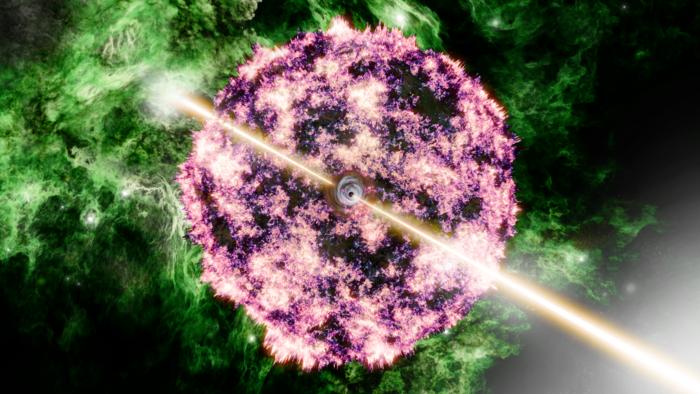In October 2022, astronomers observed the brightest gamma-ray burst (GRB) ever recorded, GRB 221009A, also known as the “Brightest of All Time” (B.O.A.T.). This powerful explosion occurred about 2.4 billion light-years away from Earth, lasting just a few hundred seconds.
Confirming the Supernova Connection
A Northwestern-led team has now confirmed that the B.O.A.T. was caused by the collapse and explosion of a massive star, a phenomenon called a supernova. Using the James Webb Space Telescope (JWST), the researchers were able to observe the supernova’s signature in the aftermath of the GRB.
A “Normal” Supernova
Surprisingly, the supernova associated with the record-breaking GRB was not exceptionally bright. “It looks fairly normal in the context of other supernovae associated with less energetic GRBs,” said lead author Peter Blanchard. “You might expect that the same collapsing star producing a very energetic and bright GRB would also produce a very energetic and bright supernova. But it turns out that’s not the case.”
The Missing Heavy Elements
The researchers then searched for evidence of heavy elements, such as platinum and gold, within the supernova. However, they did not find the telltale signatures of these elements. This suggests that extremely energetic GRBs like the B.O.A.T. may not be a significant source of heavy elements in the universe.
Solving One Mystery, Raising Another
“When we confirmed that the GRB was generated by the collapse of a massive star, that gave us the opportunity to test a hypothesis for how some of the heaviest elements in the universe are formed,” Blanchard said. “We did not see signatures of these heavy elements, suggesting that extremely energetic GRBs like the B.O.A.T. do not produce these elements.”
The Bright Afterglow and the Mysterious Jets
To better understand the B.O.A.T., the researchers combined data from the JWST and the Atacama Large Millimeter/Submillimeter Array (ALMA) in Chile. They found that the bright afterglow of the GRB was still contributing a significant amount of light, even months later. This suggests that the shape and structure of the jets launched by the collapsing star may be responsible for the record-breaking brightness of the B.O.A.T.
Clues from the Host Galaxy
The researchers also obtained a spectrum of the galaxy hosting the B.O.A.T., finding that it has the lowest metallicity, or abundance of heavy elements, of all previous GRB host galaxies. This unique aspect of the host galaxy may help explain the properties of the B.O.A.T.
Continuing the Search for Answers
While the discovery of the supernova associated with the B.O.A.T. solves one mystery, it raises another. The lack of heavy element signatures in the supernova is a crucial piece of information as scientists continue to investigate the origins of the heaviest elements in the universe. Future observations with the JWST and other powerful telescopes will be crucial in unraveling the remaining secrets of this exceptional cosmic event.

